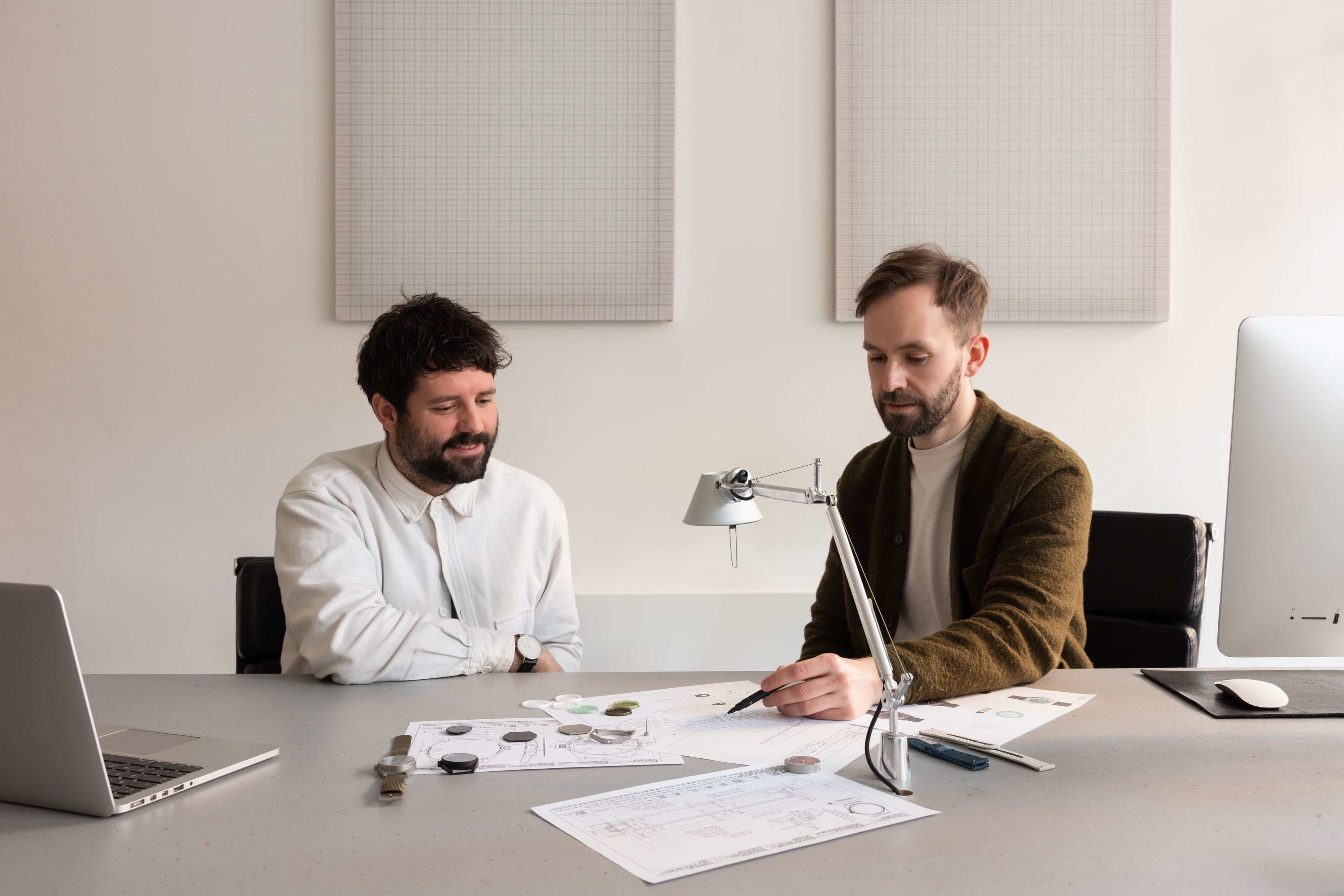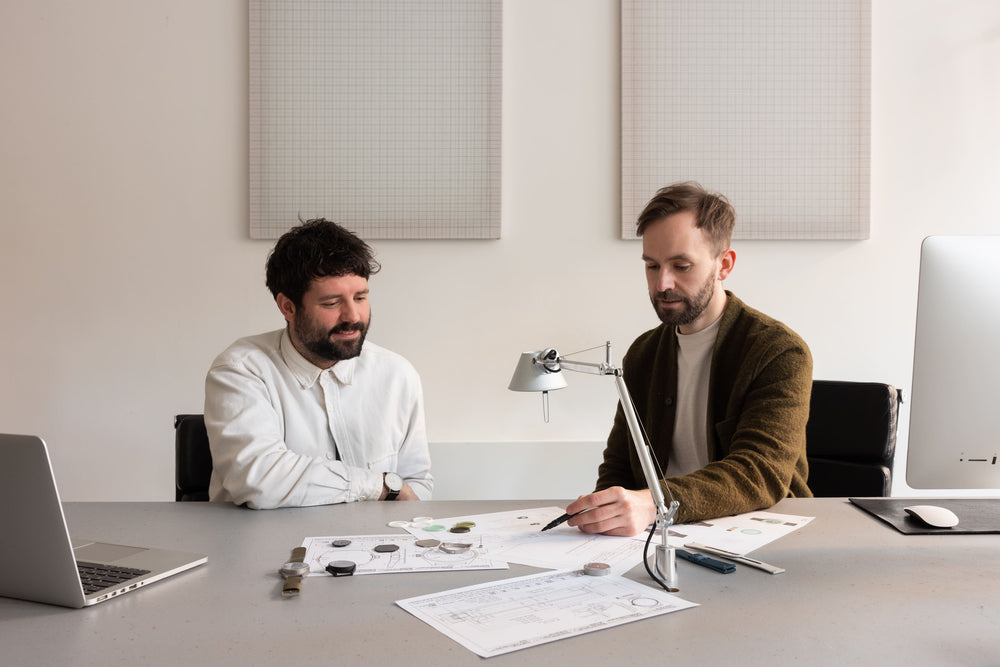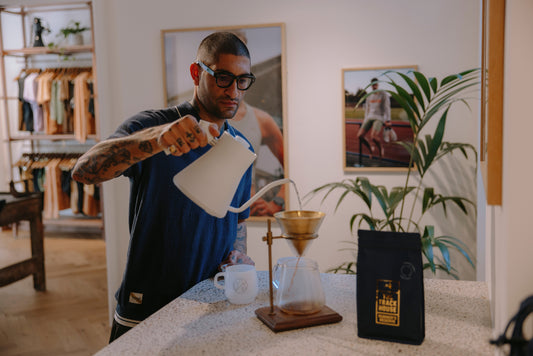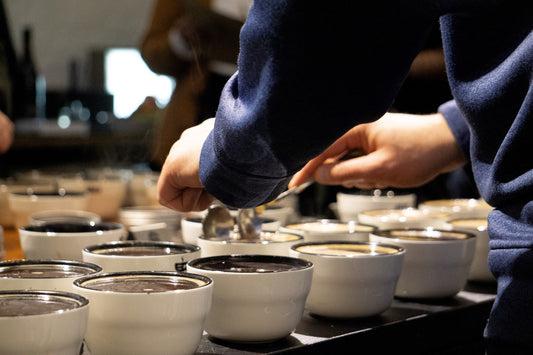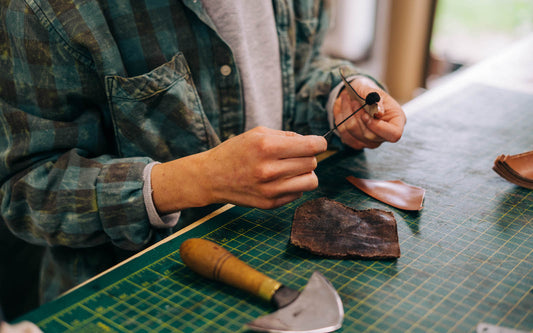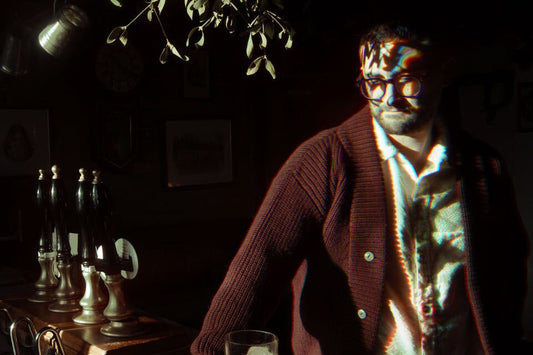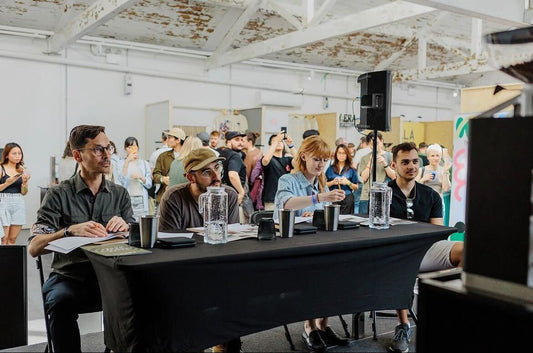
“Please don’t worry about making us sound more eloquent – we don’t have a problem with being misquoted if we sound better on the page than we do in real life”.
The humility that underpins design studio Instrmnt Applied Design (I-AD) is apparent from the moment that co-founder, Ross Baynham, begins to talk. Speaking from their Glasgow-based office, Ross and co-founder Pete Sunderland sit against a sparse white backdrop that is accented by the silhouette of Vitsoe shelves. As they sip at their cups of coffee and outline the beginnings of their multi-disciplinary design studio, it’s clear that a passion and inherent love for beautiful, functional design drives every decision they make and every product it gives rise to.
Founded in 2014, I-AD focuses on creating products that are of high quality, simple and attainable. In the past eight years, their work has been widely recognised and lauded, from the likes of V&A and London Design Festival, to The New York Times and Dezeen.
RB: “Both Pete and I were graduate designers. He was studying graphic design and I was studying product design, and both of us were working in industry. Having shared a studio in university, we knew that we both shared a visual language and design style, which gave rise to us beginning to collaborate on a personal project. We wanted to design really simple products – essentially instruments and things that were functional in nature – and we started with a really good, proven piece of technology: Ronda’s Swiss quartz movement. Designing a watch that was purely for ourselves, we didn’t just focus on the project, but created a brand too. And people really wanted it.”
PS: “With no money to produce the thousand or so pieces we needed to bring it to life, we went to the bank, who basically laughed at us, and so crowdfunded ourselves on Kickstarter. By the end of the 30 days, we’d raised £100,000, which was unbelievable. That took some fairly significant explaining to my bank when it arrived”.
Despite the success of their as-yet unreleased product, Pete says that I-AD “still didn’t feel like a real company”. Today, though, there are no reservations on whether or not that’s the case. Since launching, they’ve created four watches, a city bike, a clock, an umbrella, a day bed, a jacket and a lounge chair – and that’s not an exhaustive list.
Having been responsible for such a varied array of products and projects, is there still a red thread that holds them all together?
RB: “It’s funny, the watch has kind of become the defining product for I-AD, but that’s not what we’ve set out to do. We’ve always wanted to design a family of products with a functional, technical link that runs through them all, whether that’s an SRAM bike hub, a clock movement or, looking towards the future, an ink cartridge. We see ourselves as being here to increase the functionality of the design and build something beautiful”.
PS: “From the first watch we ever designed, we did what we were told never to do, which was design for ourselves. We made something that we wanted to use and that’s been reflected back to us by our customers. As we’ve grown as a company and as a brand, we’ve continued to break that rule. Our tastes have evolved over time and so have our products, but our customers have changed with us”.

Evolving alongside them has been the city I-AD has always called home.
RB: “Glasgow’s a large part of our identity. We’re interested in industrial design and Glasgow is a city with a rich industrial past that ranges from the way-before-its-time minimalist design of Charles Rennie Mackintosh to Glasgow’s huge history in ship building. More recently there’s its vibrant underground music scene and underground design scene too, especially coming through the 19080s and 1990s, when it was still considered a dangerous city”.
RB: “All of that combined to create an incredibly creative city right around the time we were both becoming professional designers in the early 2010s. It takes cues and hints from its industrial past and then refines them into a design style that’s rooted in minimalism and is honest. There’s no pretension and people aren’t trying to be something they’re not in their work”.
PS: “That’s just it. Much of the creative output of the city reflects the people in it – or maybe it’s the other way round – but it’s pretty cut and shut, and straight down the line. But it’s a great city to be a creative in. We’ve got The Modern Institute round the corner, a brilliant music scene, the Glasgow School of Art which churns out a lot of brilliant designers – it’s a wonderfully creative city”.

One of I-AD’s more recent projects was a chore jacket. Their first garment, in some ways it represents a departure from their usual projects, but Pete and Ross see it as a logical progression.
PS: “The jacket was a big project for us as our aim was for it to be our statement on sustainability. We’d always wanted to create a piece of clothing and it finally came about as a result of a close friend and pattern cutter leaving their job at [Scottish clothing brand] Hancock and having the time to do it”.
RB: “And I realise this is going to sound a little ridiculous, but on this project he was almost the component. He’s unique and a fantastic pattern cutter, a very modest designer and maker of clothes and he’s created a small-scale factory in his dad’s garage where he’s doing things that just can’t be done anywhere else in the country. He’s what drives that product and it’s very interesting working on that level, with the creativity of an individual defining the quality of the piece”.
Like a number of their projects, the chore jacket’s numbers were limited to just 100. A byproduct of the way I-AD works, this is another theme that runs across their range of releases.
PS: “I like the idea that we create something, sell it and then that’s it – for the most part we move on. For us that’s not to artificially create a sense of scarcity or hype; it’s more to keep it fresh and interesting for us, and, in turn, for our customers. It’s a balance though. We do think, and at times worry, about dilution. You can do everything, but be nothing, and that’s not us”.
But to be able to appeal to the same person and with the same ethos with a different range of products helps to avoid conspicuous consumption, does it not?
RB: “Definitely. In the earlier days of INSTRMNT we spent a good amount of time at fashion shows and exhibitions, where we’d see a new season dictating small tweaks and new colours across hundreds of products and thousands of brands. It didn’t take too many shows for us to realise this just wasn't a sustainable model”
PS: “We understood it – buyers and retailers want and need new things every few months to keep things visually different and fresh – but we can’t do that. We will release new iterations and colourways of certain products, but we do it on our terms. Our hope is that you buy one of our products and wear, use, sit on that product for the rest of your life. That’s why we like breadth. Taking the principles and values from one of our products and applying it to something complementary but altogether different just makes sense to us.
The topic of sustainability is an interesting one to discuss with Pete and Ross. It’s baked into their products, but their prevailing focus is on creating items that are as beautiful and simple as they can be. Is it therefore a result of the way they work, or is something they’re continuously conscious of?
PS: “We never started out with sustainability at the forefront – it was about producing the best possible products we can. It’s been a journey for us because now we have this roster of manufacturers and processes who we’ve spent eight years developing relationships with that we implicitly trust and who share our own principles. That’s allowing us to go back and drill down into what we can improve on and how we can make our products more sustainable”.
RB: “Sustainability can be such a difficult conversation, and it’s one that’s tricky to balance from I-AD’s perspective. It’s incredibly important to us in our personal lives, there’s no doubt about that, but the reality is that the most sustainable business we can have is no business at all. But if the most sustainable thing you can do is not produce products in the first place, we think the second best thing you can do is make high quality products that last for a long time, negating the need for somebody to replace it every year or two”.
 PS: “I think we’re a sustainable business, but not a sustainability business. For us, it’s a process and a journey of continual improvement. Back when we released our first watch, we’d see watches arriving in their hundreds and each one would be individually wrapped in pieces of plastic and it was heartbreaking”.
PS: “I think we’re a sustainable business, but not a sustainability business. For us, it’s a process and a journey of continual improvement. Back when we released our first watch, we’d see watches arriving in their hundreds and each one would be individually wrapped in pieces of plastic and it was heartbreaking”.
RB: “It was – they were wrapped in materials that were never going to leave this planet. Over time, and by building the relationships we have now, we’ve been able to demand that these are removed from anything that arrives with us. We’ve also been able to review our packaging, moving from virgin paper to recycled paper and our watch packaging is no1 100% recycled. That’s trickled down to products in the last year, with the release of our solar-powered Field Watch, which removes the need for batteries, and this year we’re introducing recycled stainless steel, recycled watch dials and 3D printed components using recycled plastics”.
PS: “We’re doing what we feel every business should be doing. We’re not just aiming for every product we release and project we complete to be better than the last. We’re trying to make sure it’s more sustainable”.
I-AD’s process is involved from beginning to end, but with a core team of just four people, the continuous and varied workload allows them a large amount of freedom.
PS: “We do our best work when we work organically. One week we’ll pour the majority of our efforts and energy into one thing, and the next it’ll be focused somewhere else entirely. What we’re doing reflects the movement of any given project and we like it that way.
RB: “Our system is that there’s kind of no hard and fast system”.
And what about getting stuck?
PS: “That happens on every project. We’ll spend a lot of time researching and learning about the process, manufacturing and technicalities before we properly embark on a new project. And we inevitably hit dead-ends after going way, way down the rabbithole and wind up discarding what we’ve learned. Sometimes it gets picked up further down the line on another project, but more often than not it doesn’t and you have to accept that as part of the process”.

On the subject of process, talk turns to rituals and routines. With such a fluid approach, are there non-negotiables within their weeks? Things they feel they need to do in order to maintain a degree of balance and order?
RB: “I walk to and from work every day and it’s normally my favourite part of the day, where I spend time listening to a podcast or learning something new. It’s become the most sacred part of my day”.
PS: “We do brew and drink coffee every day too. The studio will always have a coffee at the same time and we use the Moccamster to make it, which is just so simple – it’s really nice to have that level of quality in such a manageable way. It’s especially useful at that point just after lunch when you’ve got the desire to get up; to just do something and move about a bit. Brewing coffee is a perfect way to cut-off the day and restart, and I suppose refuel as well”.
Cups dry and morning slipping into afternoon, Pete and Ross prepare themselves for a meeting on an upcoming project. Before they leave, I ask them about their latest release – a third series of their Lounge Chair – which is available to pre-order now.
RB: “It’s an enormous undertaking for Lewis [Macleod, owner, designer and manufacturer at HAME, who manufacture the chairs]. Handmade from beginning to end in Glasgow, there’s only going to be 15 made this time round, which, as much as anything else, speaks to the amount of work and effort that goes into creating each one”.

With thanks to Pete and Ross for the generous offering of their time and insight. Photos captured in the I-AD studio by Richard Gaston using the Moccamaster in off white, Wilfa Svart Grinder and Workshop Coffee filter subscription.
Share:


